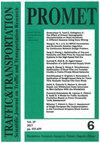Improving Traffic Efficiency in a Road Network by Adopting Decentralised Multi-Agent Reinforcement Learning and Smart Navigation
IF 1.1
4区 工程技术
Q4 TRANSPORTATION SCIENCE & TECHNOLOGY
引用次数: 0
Abstract
In the future, mixed traffic flow will consist of human-driven vehicles (HDVs) and connected autonomous vehicles (CAVs). Effective traffic management is a global challenge, especially in urban areas with many intersections. Much research has focused on solving this problem to increase intersection network performance. Reinforcement learning (RL) is a new approach to optimising traffic signal lights that overcomes the disadvantages of traditional methods. In this paper, we propose an integrated approach that combines the multi-agent advantage actor-critic (MA-A2C) and smart navigation (SN) to solve the congestion problem in a road network under mixed traffic conditions. The A2C algorithm combines the advantages of value-based and policy-based methods to stabilise the training by reducing the variance. It also overcomes the limitations of centralised and independent MARL. In addition, the SN technique reroutes traffic load to alternate paths to avoid congestion at intersections. To evaluate the robustness of our approach, we compare our model against independent-A2C (I-A2C) and max pressure (MP). These results show that our proposed approach performs more efficiently than others regarding average waiting time, speed and queue length. In addition, the simulation results also suggest that the model is effective as the CAV penetration rate is greater than 20%.采用分散式多智能体强化学习和智能导航提高路网交通效率
未来,混合交通流将由人类驾驶汽车(HDVs)和联网自动驾驶汽车(cav)组成。有效的交通管理是一个全球性的挑战,特别是在有许多十字路口的城市地区。许多研究都集中在解决这个问题,以提高交叉口网络的性能。强化学习(RL)是一种新的交通信号灯优化方法,克服了传统方法的缺点。本文提出了一种结合多智能体优势行为者批评(MA-A2C)和智能导航(SN)的集成方法来解决混合交通条件下道路网络的拥堵问题。A2C算法结合了基于值方法和基于策略方法的优点,通过减小方差来稳定训练。它还克服了集中式和独立MARL的局限性。此外,SN技术将交通负载重新路由到备用路径上,以避免交叉路口的拥堵。为了评估我们方法的稳健性,我们将我们的模型与独立a2c (I-A2C)和最大压力(MP)进行了比较。这些结果表明,我们提出的方法在平均等待时间、速度和队列长度方面比其他方法更有效。此外,仿真结果也表明,当CAV侵彻率大于20%时,该模型是有效的。
本文章由计算机程序翻译,如有差异,请以英文原文为准。
求助全文
约1分钟内获得全文
求助全文
来源期刊

Promet-Traffic & Transportation
工程技术-运输科技
CiteScore
1.90
自引率
20.00%
发文量
62
审稿时长
3 months
期刊介绍:
This scientific journal publishes scientific papers in the area of technical sciences, field of transport and traffic technology.
The basic guidelines of the journal, which support the mission - promotion of transport science, are: relevancy of published papers and reviewer competency, established identity in the print and publishing profile, as well as other formal and informal details. The journal organisation consists of the Editorial Board, Editors, Reviewer Selection Committee and the Scientific Advisory Committee.
The received papers are subject to peer review in accordance with the recommendations for international scientific journals.
The papers published in the journal are placed in sections which explain their focus in more detail. The sections are: transportation economy, information and communication technology, intelligent transport systems, human-transport interaction, intermodal transport, education in traffic and transport, traffic planning, traffic and environment (ecology), traffic on motorways, traffic in the cities, transport and sustainable development, traffic and space, traffic infrastructure, traffic policy, transport engineering, transport law, safety and security in traffic, transport logistics, transport technology, transport telematics, internal transport, traffic management, science in traffic and transport, traffic engineering, transport in emergency situations, swarm intelligence in transportation engineering.
The Journal also publishes information not subject to review, and classified under the following headings: book and other reviews, symposia, conferences and exhibitions, scientific cooperation, anniversaries, portraits, bibliographies, publisher information, news, etc.
 求助内容:
求助内容: 应助结果提醒方式:
应助结果提醒方式:


